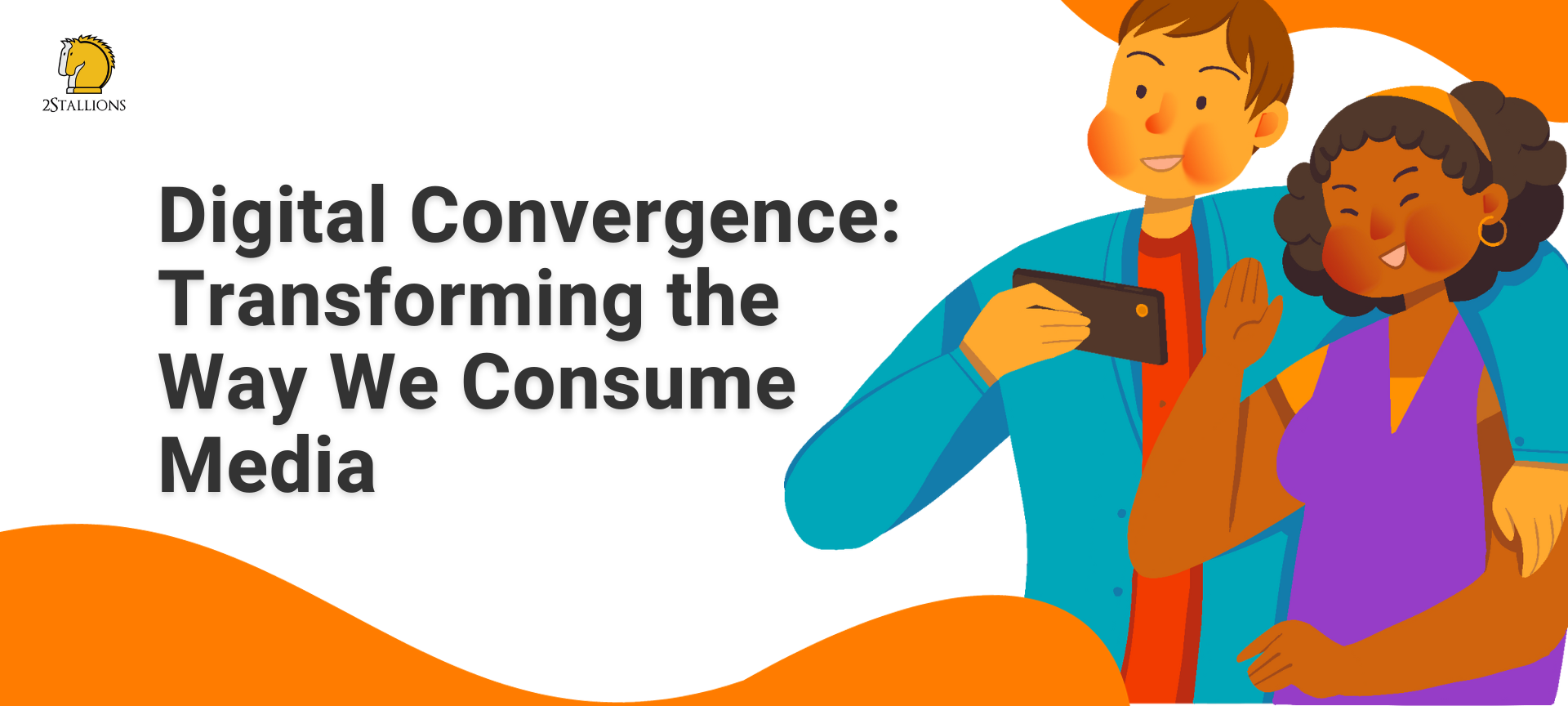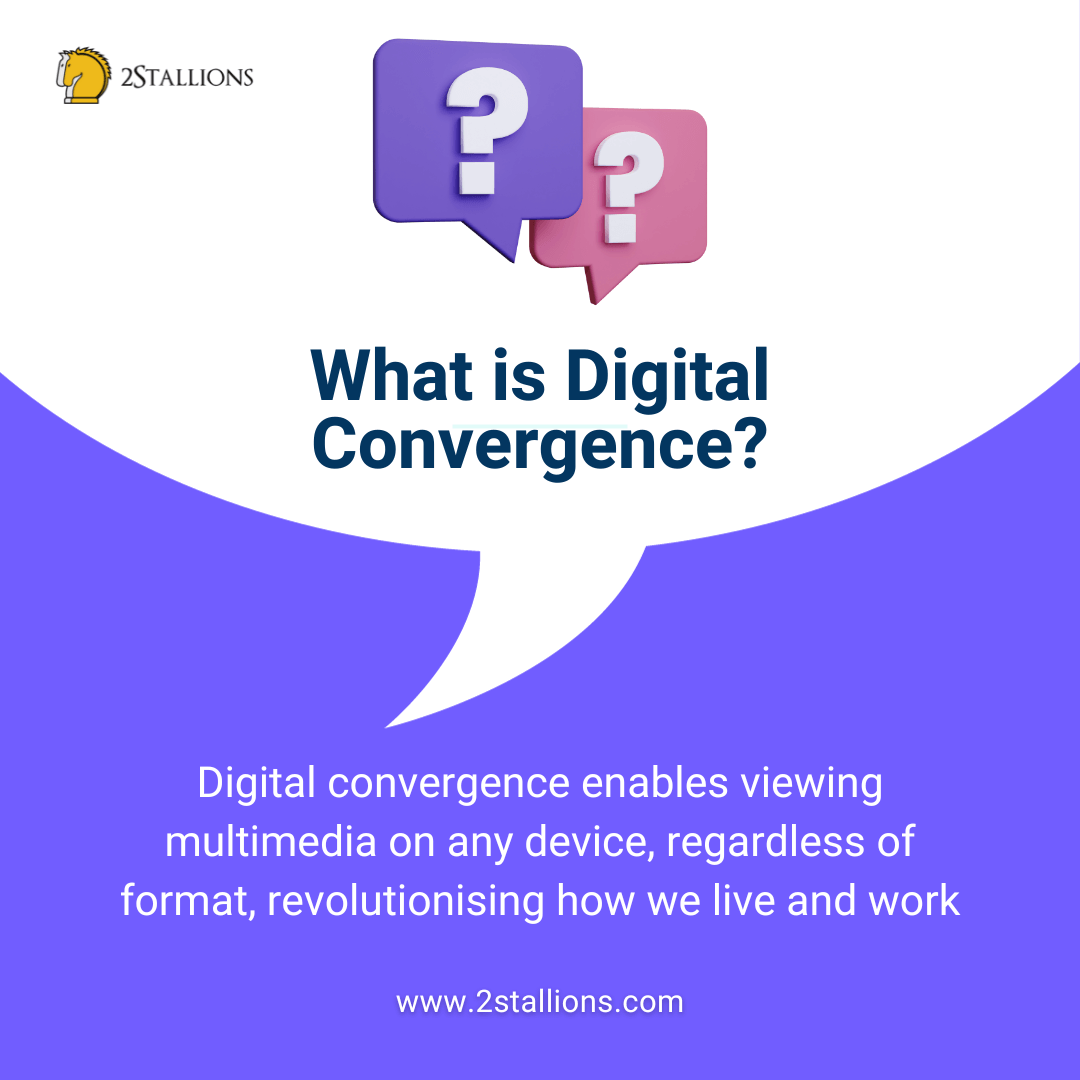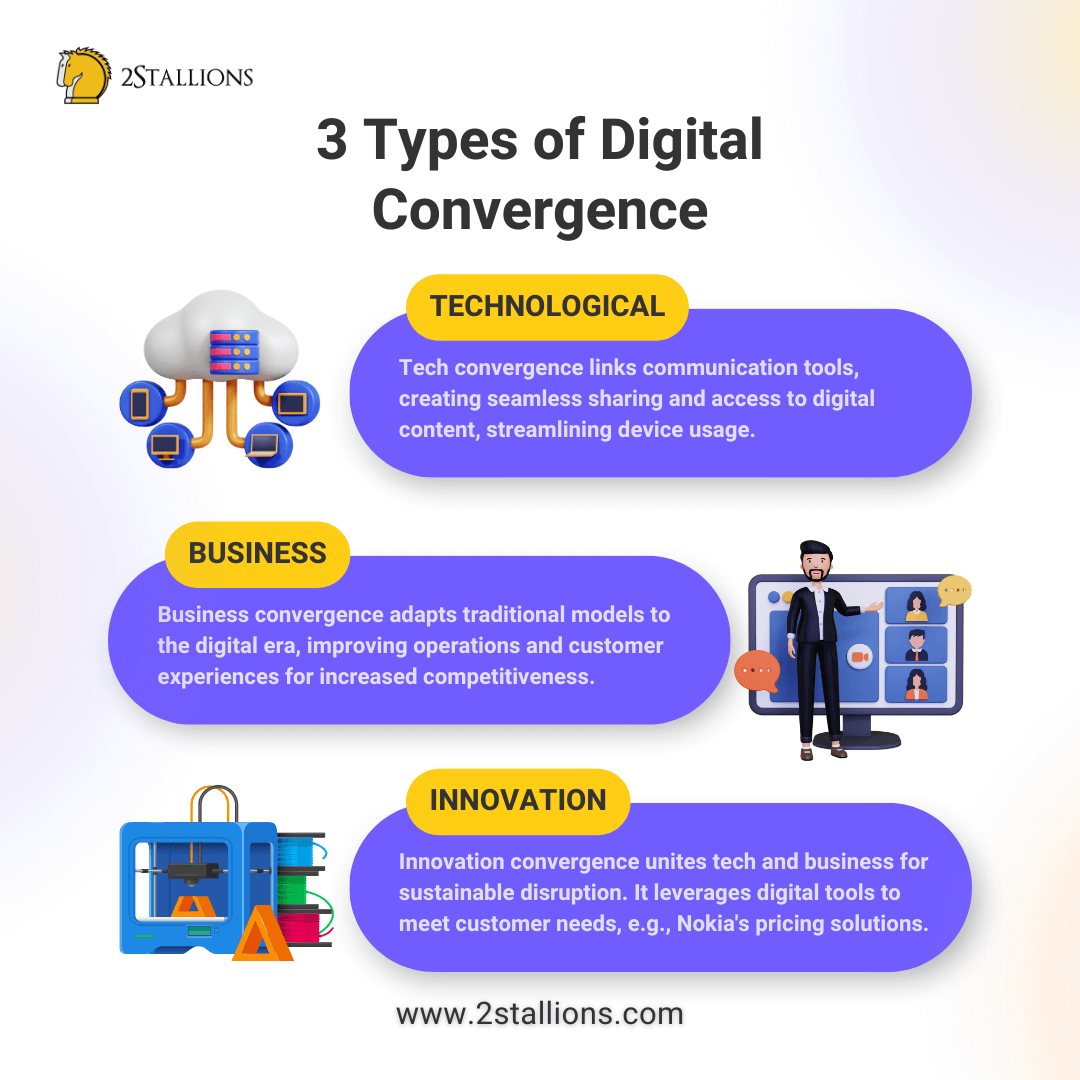Content
SHARE

Digital convergence has been around for a while, following in the footsteps of evolving technologies and upgraded networking. The development of the Internet of Things (IoT) has increased the amount of multimedia available to consumers worldwide – multimedia being the combination of audio, video, and data. There's a lot of talk about digital convergence with a global pandemic and its impact. Digital convergence has seen a massive uptake due to the digital transformation demanded by the changes of 2020. But what is digital convergence? And how has it impacted society?
[thrive_leads id='8298′]
 What is Digital Convergence?
What is Digital Convergence?
Digital convergence is using any device to view any multimedia regardless of its format. This looks pretty straightforward, but the technology is required to allow us to stream videos from our smartphones to our televisions, read emails on our tablets, or send instant messages from our computers. The seamless experiences many take for granted have steadfastly transformed our lives and work as we know it.
 Types of Digital Convergence
Types of Digital Convergence
Digital convergence refers to merging different technologies, platforms, and industries in the digital era. It integrates various digital technologies, such as artificial intelligence and smart devices, with business models and processes to drive innovation and digital transformation. Digital convergence is crucial in shaping new business models and addressing business issues in the current business landscape.
1. Technological Convergence:
Technological convergence involves the interconnection of communication technologies to create a seamless and integrated ecosystem. This convergence allows the sharing of information, services, and resources across different devices and platforms. It enables access to digital content, such as music and videos, on a single device, eliminating the need for separate devices for each media type.
2. Business Convergence:
Business convergence refers to transforming traditional business models to adapt to the digital era. It involves integrating digital technologies and platforms into business processes, leading to more efficient operations, improved customer experiences, and increased competitiveness. Digital business models, driven by digital transformation projects, are reshaping industries like the music and radio industry, where digital platforms have disrupted traditional distribution channels.
3. Innovation Convergence:
Innovation convergence combines technological innovations with business models to drive sustainable and disruptive innovation. It involves leveraging digital technologies as tools for innovation and exploring new ways to meet customer needs. Examples include Nokia's converged charging and policy controller solutions, which enable telcos to offer their customers personalised and tailored pricing plans and services.
Digital convergence is a transformative force in today's business world. Understanding the different types of convergence can help businesses and individuals navigate the digital landscape, leverage new opportunities, and stay competitive in an ever-evolving digital economy. Developing critical thinking, communication, and adaptability skills is crucial to effectively harnessing the power of digital convergence for growth and success.
Implications of Digital Convergence
Digital convergence has given society a new interconnectedness across all facets – our personal and professional existence. It has granted us universal access to information, regardless of the devices we possess. It has also allowed us to share that information more easily with others; we are no longer dependent on the content's format to be able to view or share it. This has led to improved integration in communication, not only between individuals and companies but between machines as well.
Think about it this way: if we can share information more readily across all our devices without fussing over the shape it takes or its compatibility with devices, data sharing between machines has taken on a whole new speed. The downside of digital convergence is 'fate sharing'. If everything is interconnected across one network, then if something goes wrong with the network, everything will be affected. Think of it like 'all eggs in one basket' – if the basket breaks, all your eggs will be on the floor in pieces, leaving you with a mess and no omelette.
Increased Use of Smart Devices and Wearables
The increased use of smart devices and wearables can be attributed to the ongoing process of digital convergence. These devices are critical in bridging this convergence's diverse digital technologies and platforms. Smart devices such as smartphones, smartwatches, and fitness trackers have become integral to our daily lives. They have evolved from mere communication and entertainment tools to powerful devices, enabling us to access and interact with various digital services.
These devices transform how we live, work, and interact, from healthcare to retail. In healthcare, wearables are used to monitor vital signs, track fitness levels, and even detect early signs of illnesses. This trend has also had a profound impact on consumer behaviour and expectations. Consumers now expect seamless integration between their smart devices and the digital platforms they interact with. They demand personalised experiences and instant access to information and services.
The growing dependence on smart devices and wearables introduces organisational challenges and opportunities. They need to adapt their business models and strategies to accommodate this shift in consumer behaviour. The increased use of smart devices and wearables in the context of digital convergence has revolutionised industries and consumer behaviour. Organisations must embrace this trend and leverage its potential to remain competitive in the dynamic landscape of today's digital age.
Impact on Privacy and Security Issues
Digital convergence has revolutionised how we interact with technology, but it also raises concerns about privacy and security. The interconnectedness of devices and information sharing across platforms can create vulnerabilities that pose severe risks to individuals and organisations. One of the significant impacts of digital convergence on privacy and security lies in the increased amount of shared data. With more devices and platforms connected, a larger pool of personal information can be accessed.
This raises concerns about how companies, governments, and other entities collect, store, and use this data. It places individuals at greater risk of identity theft, fraud, and other forms of privacy infringement. Moreover, the interconnectedness of devices means that a breach in one system can have a domino effect, potentially compromising multiple platforms and devices. For example, if a hacker gains access to a smart home system, they could control other connected devices, such as security cameras or personal assistants, further invading privacy and posing physical security risks.
To address these challenges, robust security measures are needed. This includes strong encryption algorithms, regular software updates, and strict access controls. Organisations must also prioritise user education on privacy and security best practices to minimise the risks associated with data sharing and interconnected devices. While digital convergence offers numerous benefits, it also brings significant privacy and security concerns. Individuals, organisations, and policymakers must proactively ensure technology's secure and responsible utilisation in the digital age.
Shifts in Consumer Behaviour and Expectations
Consumer behaviour and expectations have undergone significant shifts in recent years due to the advent of digital convergence. One major factor driving these shifts is the increased access to digital platforms and smart devices. With the widespread use of smartphones, tablets, and wearable tech, consumers now have instant access to information and services at their fingertips.
This has led to an expectation of convenience, personalisation, and seamless experiences across various touchpoints. Another shift in consumer behaviour is the growing demand for sustainability and social responsibility. Consumers are increasingly conscious of the environmental impact of their choices and expect businesses to align with their values. The impact of the COVID-19 pandemic has only intensified these transformations in consumer behaviour.
In this resilience-based structure, technology convergence plays a crucial role. Integrating robotics, artificial intelligence (AI), and the Internet of Things (IoT) has enabled businesses to automate processes, personalise customer experiences, and analyse data for better decision-making. These digital technologies have become essential for innovation and adapting to changing consumer expectations. Digital convergence has caused significant shifts in consumer behaviour and expectations. The COVID-19 pandemic has further accelerated these changes, necessitating adopting a resilience-based structure.
The Digital Convergence Revolution
Agility is one of the keys to unlocking the advantages of digital convergence. The ability to pivot based on the changing circumstances will be the difference between companies that survive the pandemic and companies that fail. 2020 taught us that digital transformation is no longer optional but demanded in the face of our unpredictable world. In this dynamic landscape, you can never know when a start-up competitor will undercut you, your industry will take a hit, or a pandemic will bring the entire world to a halt.
No matter the situation, an agile company is a resilient company. 75% of executives believe the pandemic's lasting impact will mean that we will be working faster and with more agility than before. Combined with the pandemic, the digital revolution has left behind those brands stuck in rigid systems. Those brands may never recover. Forrester predicts that lines between marketing and customer experience functionality will blur more than ever before, eventually leading to a true convergence and a definite increase in loyalty and retention marketing.
2021 will be a make-or-break year for all brands: either join the revolution or be left behind and miss out on all the new year's opportunities.
Challenges for Organisations in the Age of Digital Transformation
In the age of digital transformation, organisations face numerous challenges as they navigate the rapidly evolving digital landscape. As traditional business models are disrupted and replaced by innovative digital ones, organisations must adapt to remain competitive. The convergence of digital technologies, including artificial intelligence and smart devices, further intensifies organisations' challenges. They must understand and harness these technologies and effectively integrate them into their business processes.
This requires a deep understanding of digital convergence's potential benefits and risks and the ability to leverage it for innovation. Additionally, organisations must consider the social and ethical implications of their digital transformation initiatives and ensure they align with corporate social responsibility. To overcome these challenges, organisations must maintain ongoing investments in digital transformation projects, foster a culture of innovation, and equip their employees with the necessary communication and critical thinking skills to thrive in the digital age.
Final Thoughts
Digital convergence has paved the way for the future of technology, representing a natural evolution driven by the impact of digital transformation. It's a trend that is here to stay. It empowers the IoT and drives the strategies behind digital marketing, research, and development for new technologies, improving how we gather, communicate, track data, and automate systems.
Where will it all lead? Only time will tell, but with the rise of seamlessly integrated technologies like smart home devices and voice controls, we can assume that digital convergence will give birth to a single digital ecosystem somewhere down the line.
Originally published: 07 Jan, 2021
Updated: 12 September, 2023
Elevate Your Online Presence With a Leading Singapore Digital Agency Specialising in Internet Marketing Strategies. Our expertise lies in seamlessly blending the realms of digital convergence, ensuring your brand thrives in today's dynamic online landscape. Explore innovative solutions tailored to propel your business forward with precision and impact.
Frequently Asked Questions About Digital Convergence
What is Meant by Digital Convergence?
Digital convergence refers to integrating different technologies, media formats, and devices into a unified digital platform. It's merging distinct technologies, industries, or devices into a broader, more versatile system.
What is an Example of Convergence?
A classic example of convergence is the smartphone. It combines the functionalities of a telephone, camera, music player, computer, GPS, and more into a single device. Another example is a smart TV, which combines traditional television broadcasting with internet browsing and streaming capabilities.
What is the Basic Concept of Convergence?
The basic concept of convergence is the merging or integrating of different media forms. It's the process where several media channels unite and operate in synergy. For example, the Internet, television, and newspapers are separate media forms. Still, they converge when a news article is read online via a smartphone or a TV show is streamed over the Internet.
What Are Convergence Culture Media Examples?
Convergence culture refers to a shift in media consumption where consumers actively participate and interact with multiple media platforms. Examples include fans discussing TV shows online, creating memes, or remixing music and videos. Another example is blending video gaming with movies, where stories and characters transcend across both mediums.
What Are the Benefits of Convergence?
Convergence offers numerous benefits. It involves multifunctional devices with various consumer capabilities, potentially resulting in cost savings. It also ensures a more seamless integration of different media forms for a more enriched user experience. For businesses, it presents opportunities for new revenue streams, increased audience engagement, and the ability to tailor content for various platforms. It also paves the way for innovative product and service offerings as industries overlap.

 Types of Digital Convergence
Types of Digital Convergence










